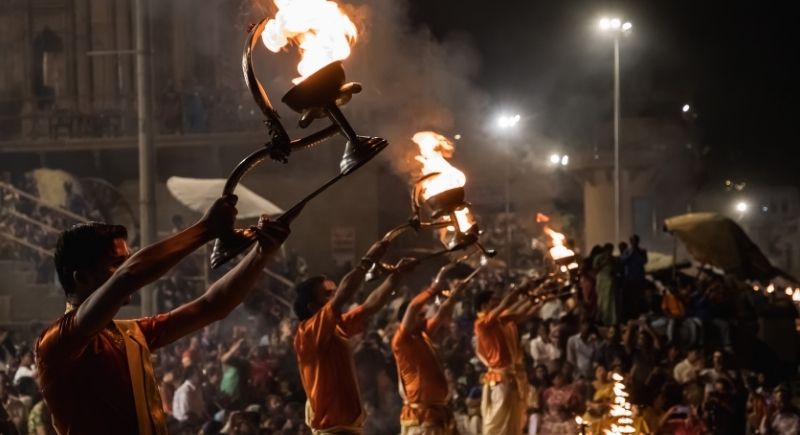Dashashwamedh Ghat, one of Varanasi’s oldest and most sacred Ghats, is also the Ghat that receives the highest number of visitors. The Ghat is known for the Ganga Aarti, which hundreds of travellers and devotees attend every evening. The Ghat is close to the Vishwanath Gali, which makes it popular with devotees wanting to take a bath before visiting Shri Kashi Vishwanath Temple to worship Shivling.
History and Dashashwamedh Ghat
The term “Dashashwamedh”, which translates as “the ghat with ten horses sacrificed,” is linked to a mythological event in Hinduism.
Legend has it that Lord Brahma performed a grand ceremony called Dashashwamedh Yajna at this site, which involved the sacrifice of 10 horses. It was thought that the yajna established Varanasi’s status as the most holy city in Hinduism.
The Ghat is a historical site that has seen the rise and fall of different dynasties in the area. For centuries, it has been the centre of religious and cultural activities.
Dashashwamedh Ghat’s current structure was constructed in the 18th Century by Peshwa Balaji Baji Rao. The Ghat features a row of ornate steps that lead down to the Ganges River, along with temples and shrines dedicated to various Hindu deities.
Evening Ganga Aarti at Dashashwamedh Ghat
The Evening Ganga Aarti on the Ghat is one of Varanasi’s most spiritually uplifting and mesmerizing experiences. This ritual has been performed along the ghats in Varanasi for centuries.
Dashashwamedh Ghat is the most popular place to attend Evening Aarti.
Legend has it that Lord Brahma performed a Yagna at Dashashwamedh Ghat to bring Lord Shiva back from exile. Since then, there has been an aarti for the Mother Ganga every evening. It’s difficult to say if the current format of the aarti is the same as the ancient format. The current format began in 1991.
In Vedas, it is said that taking part in the Ganga Aarti cleanses the soul and creates an environment of positivity.
Ritual & Process of Evening Ganga Aarti at Dashashwamedh Ghat
- The aarti was performed by seven young Brahmins from Kashi, who represent the Sapta Rishis that offered their Pujas to Maa Ganga.
- Mantras are chanted and melodious Bhajans sung in praise of Lord Shiva (Shri Vishwanath ) and Lord Vishnu. The aarti always takes place facing the River Ganga.
- All priests performing the aarti wear the same outfit: a dhoti or kurta and a stole (colours can be white, saffron, pink, gold, red, or a mixture of colours). Before the aarti begins, the priests begin the preparation.
- The young priests begin the aarti by chanting mantras (shaking) and blowing on the conch shell. On the central platform, a picture of Maa Ganga is displayed. The platform is decorated with flowers and garlands.
- The ritual is a predetermined sequence. Incense and flowers (manifestly by hand gestures) are offered to water.
- The priests then move the large brass lamp with many lit small lamps in a clockwise motion in a rhythmic fashion. This lamp is layered to look like Sheshnag, the snake-ruler Sheshnag. Narayana, the Narayana version of Vishnu, is usually shown resting on Sheshnag with his consort Lakshmi.
- All these movements, incense burning and lamp-movement, etc., are accompanied by constant chanting of Mantras. There is constant chanting and Har Har Mahadev. Even in the midst of a crowd, there is an air of calmness and magic. There is a sense of peace within the chaos.
- The River Ganga, or Mother Ganga, is offered fresh flowers at the end.
- The evening Ganga Aarti is an experience that should be noticed.
Dashashwamedh Ghat Evening Aarti Timing
During Summer - 7:00 PM
Winters - 6:00 PM
Total duration approx 45 minutes
Entry Fee or Charge for Dashashwamedh Ghat or Ganga Aarti

Please be aware that there is no charge for entry to the Aarti or the Ghat. The aarti can be witnessed depending on the availability of space and when one arrives at the Ghat.
You can watch the aarti in different ways – either from the Ghat or by paying for a special VIP seat right next to the Aarti platform area. There are different ways to witness the aarti – from the Ghat (fees for special VIP seats – right next to the Aarti area where there are aarti platforms – charges could be anywhere between Rs. 2000).
How to reach Dashashwamedh Ghat?
By Air
Varanasi has its own airport, Lal Bahadur Shastri Airport (VNS), with connections to major Indian cities. Upon arrival, you can take a prepaid taxi, regular taxi, or rickshaw to reach the ghat. Ride-hailing apps like Uber or Ola are also available.
By Train
Varanasi Junction (also known as Kashi Vishwanath Temple Station) is the main railway station in Varanasi and is well-connected to most parts of India. From the station, you can take an auto-rickshaw, rickshaw, or e-rickshaw to reach Dashashwamedh Ghat. The distance is relatively short and manageable through these options.
From a bus stop or railway station
Hire a car and ask it to drop you off at ‘Godowlia’. Then, walk for 5 minutes until Dashashwamedh Ghat, as vehicles are not allowed beyond this point.
Local Transport
To reach Dashashwamedh Ghat, you can take an Auto Rickshaw to ‘Godowlia.’ It will cost Rs 20. You can walk for 5 minutes to Dashashwamedh Ghat from Godowlia Market, as no cars are allowed beyond the limit.
The rhythmic chants, flickering diyas, and the mesmerizing flow of the Ganges – the Dashashwamedh Ghat offers an experience that goes beyond sightseeing. It’s a place where the essence of Varanasi unfolds, a tapestry woven with history, spirituality, and the timeless connection between humanity and the divine river. As you depart, take a piece of this magic with you, a reminder of the profound beauty and spiritual depth that resides in the heart of Varanasi.